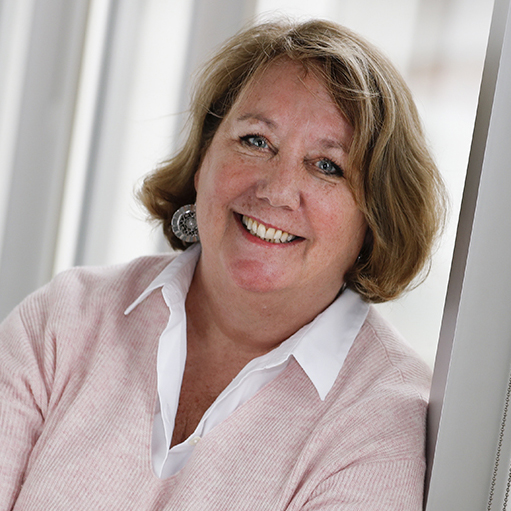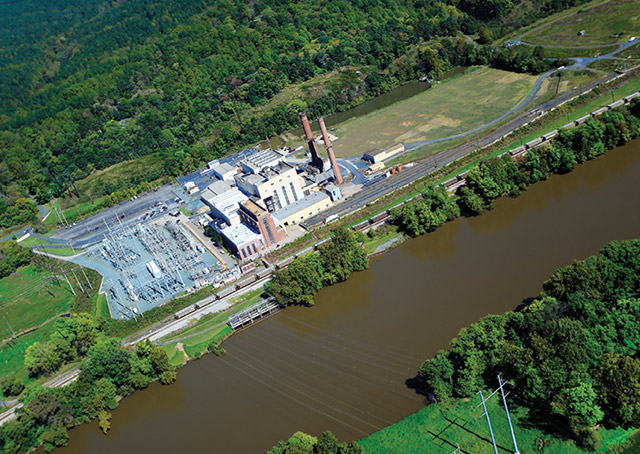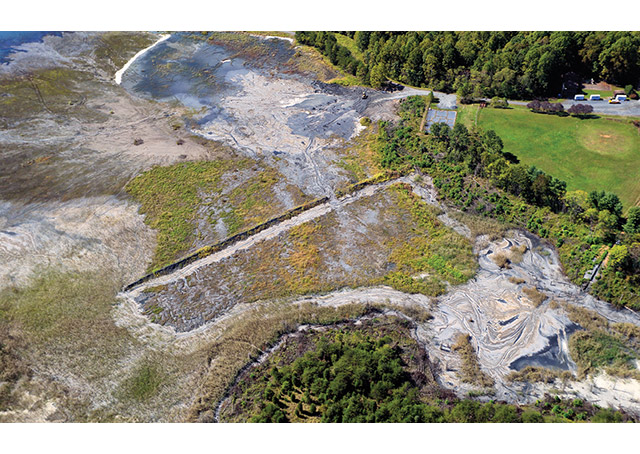Locals call the river that runs through Richmond, Virginia, “James Brown” when it looks like this: a slick coffee-with-a-little-cream color that isn’t appetizing. Not even Starbucks could sell it.
When it’s not colored by mud after a major storm, the James River is a rock star to this southern city, voted by Outside magazine as the nation’s best river town. “On a warm day like this, there are usually thousands of people out on the river,” says Pat Calvert, the Upper James Riverkeeper, whose job it is to monitor the health of Richmond’s river.
Calvert is a member of the nation’s Waterkeeper Alliance, and he and other waterkeepers—there are about 250 across the country—call on the help of groups such as SouthWings, an environmental nonprofit organization that supplies aircraft and volunteer pilots to monitor the Southeast’s waterways from the air.
Calvert is looking for signs of coal ash runoff and livestock access along the river, which contribute pollutants “you don’t want in your drinking water,” he says. The volunteer pilot is Hap Endler, who has been flying his Cessna Skylane on SouthWings missions for the past 10 years. Endler is based in North Carolina, where riverkeepers look for similar pollutants, including offal from chicken farm as well as runoff from lumber companies and coal mining, that strip mountains and produce dangerous sediments in the rivers and other waterways.
Calvert has Endler fly along the river near the parallel railroad track. In addition to possible waste, Calvert would like to see evidence of trains bearing crude from the Bakken oil fields in North Dakota. The freight companies do not publish when the trains run, and Calvert sees potential danger in an oil spill from a train wreck—much like what happened in Lynchburg, Virginia, in 2014 when a train derailed and spilled 30,000 gallons of crude oil into the James River. Taking photographs as we fly along the river, Calvert mumbles, “I want to see a train, a mile-and-a-half-long train.”
He does see a freight train, a power plant, submerged tanks, cows dangerously heading toward the river (who knew cows and chickens posed such threats?), but no crude-oil-laden trains. In fact, it’s a beautiful flight along one of the country’s most historic rivers—albeit not at its best—and over gorgeous landscapes.
Conservation through aviation
This is a typical flight for the pilots of SouthWings. Based in Asheville, North Carolina, the 20-year-old nonprofit conservation group connects passengers with pilots, says David Moore, flight coordinator. “We call our work ‘conservation through aviation,’ which seems like an oxymoron. But the aircraft is a tool, a platform. We give an aerial perspective of things on the ground.”
Moore has been with the group just three years, and he admits that he thinks airplanes first, environment second. A CFII and airline transport pilot, Moore has more than 3,000 flight hours and loves to fly. “But I see the need. I like the Earth I live on.”
Founder Hume Davenport says, “We’re pilots first, but we want to make a difference.” Davenport flew for the environmental group LightHawk in the western United States and, being from Chattanooga, Tennessee, recognized the same need on his side of the country. He graduated from the University of Richmond and flew regularly over the mountains of the Blue Ridge, Appalachia, and rivers like the James.
“My cousin Bobby Davenport, and lifelong friend Jay Mills, and I founded SouthWings in late 1996. Bobby, Jay, and I love to fly and are passionate about conserving land and special places for the future,” says Davenport. “We set out to collaborate with leading conservation and community organizations to discover, interpret, and advocate for solutions to environmental problems from an aerial platform. We wanted to fly and educate individuals with the greatest potential to influence positive environmental change.”
SouthWings has a cadre of volunteer pilots who offer their aircraft for flights requested by environmentalists who want to research areas they cannot see on the ground. “We are not in the business of sightseeing,” Moore emphasizes. “The airplane is a valuable tool that is underutilized. We take passengers who want to bring an issue to the public. And we want to make sure the ripple effect happens—that it gets to the news media, the public sees it.”
SouthWings flights have appeared on CNN, the National Geographic Channel, and many others. The organization has flown government officials and celebrities, including Robert Kennedy Jr., who heads the Waterkeepers Alliance.
Swaths of destruction
SouthWings’ priorities are water health, as in the riverkeeper flights; coastal land loss, predominantly on the Gulf Coast around New Orleans; and mountaintop removal, mostly in Virginia, West Virginia, and Kentucky. In New Orleans, SouthWings opened an office, headed by environmentalist Meredith Dowling, because the coastal land loss in the area is at the rate of losing a football field of land every hour.
“The BP oil disaster of 2010 caught us—and everyone we knew—completely by surprise. SouthWings volunteers did heroic work getting journalists, photographers, community leaders, and many others in the air to show the world what was happening,” Dowling says. “In the aftermath of that disaster, we redoubled our commitment here, working with partners such as the Waterkeepers Alliance to shine a light on the pollution events that continue to plague the Gulf of Mexico and its coastlines every day.”
SouthWings opened its New Orleans office in 2012. “Building public and political will to restore the important ecosystem of the Mississippi River Delta is now a primary goal of our Gulf flight program,” Dowlings adds.
Mountaintop removal is a classic example of the microscope SouthWings can put on an issue. For many years it was SouthWings’ “bread and butter,” Moore says. “It was hard to see the destruction from the ground. We took hundreds of flights with environmentalists, government officials, the media. They had no idea it looked that way—we showed them the swaths of destruction [that] mountaintop removal causes.”
A decline in the coal industry and falling coal prices have somewhat slowed activity on this issue, but Moore says, “In West Virginia you are either for or against coal, and when coal companies see a plane fly low and slow, they know we’re looking. They will do their best to stop us. But we have a right to do what we do and bring back the information.”
Pilots who ‘get it’
Moore’s primary role with SouthWings is pilot recruitment. The organization is always looking for volunteer pilots. There are 50 regular pilots who volunteer and fly an average of 95 to 120 flights per year, each about one to two hours in duration. They are not paid and usually are not remunerated for fuel. SouthWings operates through environmental grants and from donations from organizations such as Patagonia, Blue Moon, and individual donors.
“We look for pilots who own or have access to [Standard] category aircraft,” Moore says. “The ‘perfect’ aircraft is a high-wing Cessna that can carry three to four people. The Cessna allows them to see the ground unobstructed.”
Although Cessnas are the norm, SouthWings also enlists the aid of a Pilatus pilot/owner—“we can pack it full of VIPs”—and an open-cockpit biplane, because “those views are great,” says Moore.
To fly for SouthWings, pilots must have 750 hours as pilot in command, but they do not have to be instrument-rated. “We fly on good-weather days—we need to be able to see,” Moore says. But the pilots must have the experience to conduct continuous low flight, circling and maneuvering over changing terrain.
Moore conducts the interview. “I can get a good sense of people’s passions when we talk,” he says. He has used AOPA’s regional fly-ins to meet pilots he otherwise would not encounter. “The regional fly-ins have really helped us paint a local area,” he says.
Hap Endler is a retired U.S. Navy pilot who has been flying for SouthWings since 2005. A friend of Davenport and resident of Asheville, Endler said joining SouthWings was a natural for him. “I have been an outdoorsman my whole life,” he says. “SouthWings puts people in the place to see the environmental issues that need attention.”
Endler flew over the BP oil spill in 2010, over mountaintop removal areas in West Virginia, and the coal ash spill in Kingston, Tennessee, in 2008. “To see the environmental damage from the air, to see the sheer scope of mountaintop removal—they are just being chopped off,” he shakes his head. “Regardless of your political affiliation, and wherever you stand on the debate, clean air and clean water are vital to everyone.” He now serves on the board of directors. “I will fly for SouthWings as long as they’ll let me fly.”
Riverkeepers
Pointing to a nearly invisible gap along the river between shore and trees, Calvert asks Endler to maneuver his Skylane tightly around the area, circling and circling until Calvert gets the photo he wants. He’s identifying a spot where this coal ash storage site—essentially “an unlined hole in the ground containing millions of gallons of toxic waste, including mercury, arsenic, and other heavy metals,” Calvert says—is connected to the James River.
“SouthWings is able to provide recipient organizations like ours an otherwise impossible frame of reference of real-world conditions and changes,” says Calvert. “They provide a powerful eye-in-the-sky perspective that empowers effective conservation and environmental protection efforts.”
The partnership with the James River Association and its “Our River at Risk” campaign is relatively new for SouthWings. Employing three flight models—monitoring and survey flights, which assist in data gathering; flights of persuasion, which give community leaders a bird’s-eye view of their environment; and media flights for journalists and photographers to capture the story—the SouthWings projects have evolved over 20 years. Many concerns are prolonged issues with effects that can have an impact long after they’ve first been identified.
“Environmentalism is a weighty word,” Moore says. “But I believe there is not a person alive who doesn’t believe in the need for clean water. If there is a problem, I would want to know about it. We can shed the light. We can expose it. And bring it to an end.”
Email [email protected]
Web: www.southwings.org
Volunteer pilots needed
Connect with conservation groups in your area
CAVU (“Calm Air Visibility Unlimited”). This Texas-based organization serves the United States and Central America.
LightHawk (Illuminate, Empower, Protect). This Colorado-based organization serves North and Central America.
SouthWings (Conservation through Aviation). This North Carolina-based organization serves the Southeastern United States.










